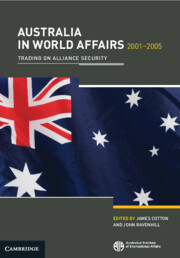Book contents
1 - ‘Trading on Alliance Security’: Foreign Policy in the Post-11 September Era
from Part 1 - The Foreign Policy Scene
Published online by Cambridge University Press: 04 May 2024
Summary
Foreign policy in the period covered in this volume was largely dominated by the Australian response to the events of 11 September 2001 and its consequences. A federal election campaign was keenly anticipated at that time, but foreign policy issues – beyond the question of the treatment of asylum seekers – were not expected to be a major concern. Little that had happened so far in that year prefigured what was to come. The new George W. Bush administration in Washington had signalled its intention to adopt a distinctive and less internationalist stance, refusing to adhere to the Kyoto Protocol (intended to restrain the global emission of greenhouse gases) and taking a much more critical view of the rising power of China. Although there were signs that on these issues Australia was likely to follow the US lead, and the initiation of studies on the impact of a free trade agreement with the USA was a further indicator of the potential similarities in outlook of the two governments, the closeness post-11 September of the Howard Government’s alignment with its Washington counterpart surprised even some conservative commentators.
Keywords
- Type
- Chapter
- Information
- Australia in World Affairs 2001–2005Trading on Alliance Security, pp. 3 - 16Publisher: Cambridge University PressFirst published in: 2024



